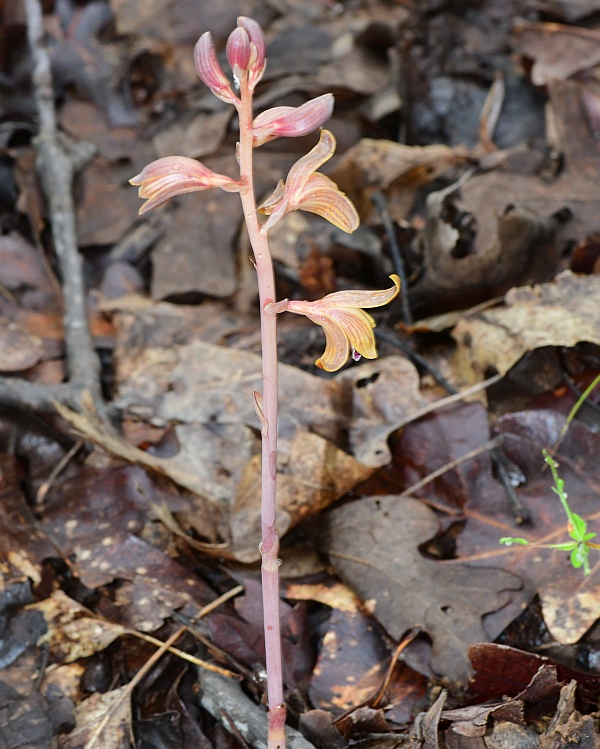Hexalectris spicata (Walter) Barnhart
Crested Coral Root

Native
CC = 8
CW = 5
MOC = 24
© SRTurner
Hexalectris spicata (Walter) BarnhartCrested Coral Root | |
 |
Native CC = 8 CW = 5 MOC = 24 |
© SRTurner |
|
Family - Orchidaceae Habit - Saprophytic forbs, lacking chlorophyll, glabrous, with thick rhizomes encircled at regular intervals by scars of successive sheathing bracts. Stem - Flowering stems 15-90 cm long, yellowish brown, sometimes tinged with purple.
Leaves - Absent except for highly reduced, sheathing bracts. Inflorescences - Terminal raceme of 8-25 flowers.
Flowers - Sepals 13-25 mm long, lanceolate or narrowly oblong, yellowish brown with purple veins, the lateral sepals slightly shorter than the upper sepal and somewhat curved toward the tip. Lateral petals 14-21 mm long, narrowly obovate to narrowly elliptic, yellowish brown with purple veins. Lip 13-20 mm long, obovate to ovate, shallowly 3- lobed, the middle lobe broadly fan-shaped with 5 longitudinal ridges toward the base, the margins undulate, white to yellowish white with purple or rarely brown veins and ridges. Column 11-18 mm long, white. Stamen 1, staminodes lacking.
Fruits - Pendent capsules, 16-30 mm long, more or less elliptic in outline, strongly ribbed, the tip somewhat flattened. Flowering - July - September Habitat - Dry upland forests, bluff tops on calcareous substrates, margins of dolomite glades, frequently under Juniperus. Origin - Native to the U.S. Lookalikes - Distantly, Monotropa hypopitys (pine drops), Corallorhiza sp. (coral root orchid). Other info. - This orchid is found in scattered locatins in the southeastern two thirds of the state, and beyond Missour is scattered through much of the south and southeast U.S. It is not common, though may possibly be underreported, being somewhat inconspicuous. Its drab tan sepals tend to blend in visually with woodland detritus such as old leaves, and it is often fairly small. Up close, the flowers are striking, with attractively striped lateral petals and a purple striped lip. This species tends to be larger in size, with larger flowers, relative to Missouri's species of Corallorhiza. Species of both genera are saprophytic, lacking chlorophyll and having no means to utilize sunlight to produce food. Photographs taken at Shaw Nature Reserve, Franklin County, MO, 7-14-2025 (SRTurner). |